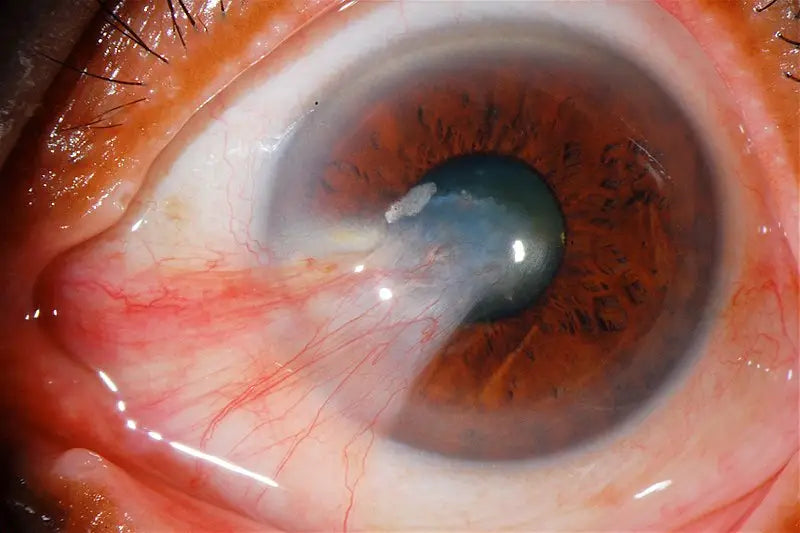Surfer’s Eye—Treating and Preventing Pterygium
Share
Surfer’s Eye—Treating and Preventing Pterygium

Photo Credit to commons.wikimedia.org
Recently I’ve noticed that my eyes are irritated and red after surf sessions, and I eventually decided to go see my ophthalmologist about it. After checking out my eyes, they told me that I have something that is very common in surfers—so common, in fact, that it’s been nicknamed “surfer’s eye.” My eye doctor diagnosed me with a pterygium, which is a growth of pink, fleshy tissue on the conjunctiva, which is the clear tissue that coats your eyeball.
Sounds pretty gnarly, huh?!
As crazy as it sounds, it’s likely that many of you reading this also have pterygiums growing. Men between the ages of 20 and 40 who live in the tropics (and especially near the equator) are the most likely demographic to develop pterygiums, and the incidence goes way up if you are a surfer. The reason for this is because pterygiums are caused by excessive exposure to sunlight, as well as wind and dry eyes. Sound familiar? Between the tropical sun, trade winds, and salt water here in Hawaii, we are all prime candidates for pterygium growth.

Fortunately, even though they look pretty rough, pterygiums aren’t super concerning. They don’t cause any long-term issues, aside from irritating your eyes, making them red, and eventually, if left untreated for a really long time, encroaching on your pupil and interfering with your vision. Most people simply live with them and treat them conservatively.
If symptoms get to the point where you can’t handle them anymore—or if you simply don’t like the look of that milky growth on your eye—you can get pterygiums fixed through a surgery that removes the lesion, then replaces it by gluing or stitching another piece of conjunctiva into place! That didn’t sound very good to me, so I asked my ophthalmologist if I had any other options, and she said that I did. Her suggestion was to try to avoid overexposure to sunlight (no chance of that!), and to use eyedrops after I surf. She suggested Refresh Tears, and as soon as I started using the drops I immediately found relief! I noticed that my eyes were way less red and itchy after surf session. Now I use the drops after every surf, and sometimes even use them if I’ve been out in the sun all day doing things on land as well.
For people who have really bad pterygium symptoms, but who don’t want to get surgery, there are also over-the-counter eye drops and ointments. And if you want to get really aggressive, you can get prescription steroid eyedrops that are quite effective in reducing symptoms such as itchiness, redness, pain, and swelling in your eyes.
Of course, there are also ways to prevent pterygiums from forming (or, if you already have one, to keep it from growing any larger), the most obvious of which is to avoid spending too much time in the sun. But since we surfers are out in the sun every day (in the ocean, which actually reflects the sunlight and exposes us to even more UV rays), we have to find creative ways to limit the sun exposure that our eyes get. There are a number of surfing sunglasses that have straps to keep them in place so you can wear them during sessions, and also surf hats with big wide brims that help keep the sun out of your face. And while on land, it is a no-brainer to always be wearing sunglasses and a hat, especially if you are in direct sunlight. You want sunglasses that block both UVA and UVB light, and wraparound sunglasses tend to offer the most protection, both from sunlight and wind and dust (which can both contribute to pterygium growth and eye irritation. And again, the eye drops that keep your eyes from drying out are a great way to prevent irritation, even if you haven’t spent the morning surfing!
While pterygiums can be a bit annoying and look pretty gnarly, it was a huge relief for me to find out that I didn’t have anything really serious wrong with my eyes. Thanks to the advice of my ophthalmologist and the great eye drops made by Refresh Tears, I am still out in the water every day—and when I head home after my daily session, my eyes aren’t red and itchy anymore! If you have a pterygium growing or if your eyes are irritated after you surf, I suggest you try out some eye drops and start wearing sunglasses. There’s no reason a bit of sun should keep us out of the water!
